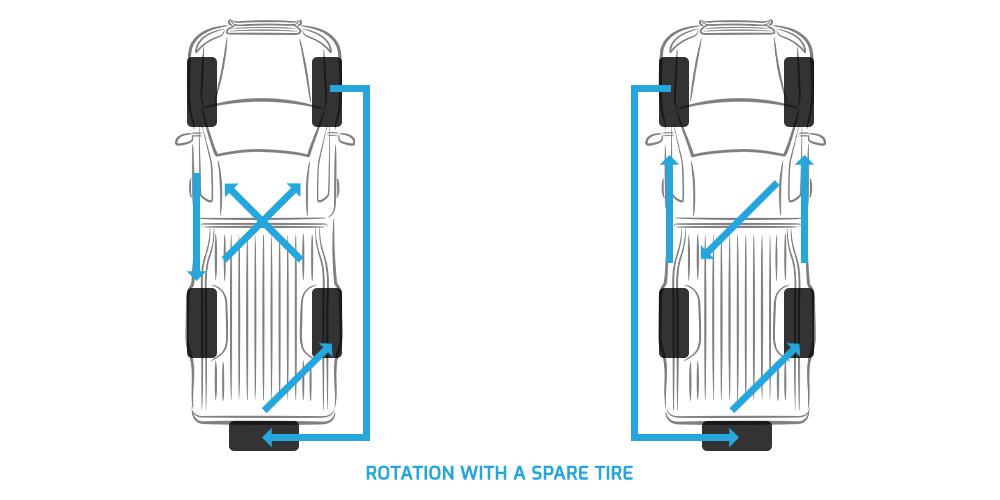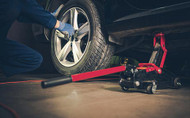Why is Tire Rotation Necessary? (Tire Maintenance Basics)
Posted by Agota Szabo on Oct 5th 2022
Tire rotation is a crucial part of regular tire and vehicle maintenance. It is an important service that should be done periodically to ensure your driving safety.
Don't be fooled! Tire rotation is necessary.
No matter how much is a tire rotation, it will save on your budget in the long run. It lengthens the tread life and usability of the tires, while also protecting the vehicle's performance.
What is Tire Rotation?
Tire rotation is basically taking the tires off the vehicle and rearranging them. By placing the tires into different positions, they will face various pressures during their service. In this manner, vehicle owners ensure that all four tires wear in the same manner.
Do you know how your front tires tend to wear out faster than the rear ones (at least for front-wheel-drive cars)? Well, this is because more pressure is placed on those wheels. If we change their position, we give them a deserved break - we also abuse the two tires now on the front axle, but we will not talk about that. Still, this allows tread wear to be even across all four tires.

However, when you rotate your tires, the rotation pattern is also crucial. So, how to rotate tires correctly?
Depending on the wheel drive of the vehicle you own, the proper way to rotate tires will differ. A front-wheel-drive and RWD tire rotation will be similar, but different. The same goes for all-wheel-drive and four-wheel-drive vehicles as well. Furthermore, directional tires and staggered vehicles will have distinct tire rotation patterns as well.
Let's take a look at the correct tire rotation patterns for each vehicle type.
The FWD Tire Rotation Pattern (Front Wheel Drive Vehicles)
The proper tire rotation pattern for FWD cars is the forward cross. When you rotate your tires on such vehicles the front tires move straight back to the rear axle. On the other hand, the rear tires are crossed and moved to the front axle in an X-pattern. The FWD rotation pattern will ensure the tread wear is even on all four tires.
Additionally, these vehicles can also use the X-pattern rotation. This means that front tires are moved to the back and vice versa, all to opposite sides from their previous placement.
The Rear Wheel Drive and 4x4 Tire Rotation Pattern
The 4-wheel-drive tire rotation and RWD tire rotation pattern are identical. Both vehicle types use the rearward cross rotational pattern. With this, the rear tires are moved straight to the front axle. The front tires are replaced on the back in opposite positions from their previous ones.
What about AWD Tire Rotation? (All Wheel Drive Vehicles)
The all-wheel-drive (AWD) tire rotation pattern is also the criss-cross one. With this, the tires are moved from the front to the back, in an X-pattern. This means that the rear left tire is moved to the front right position, and the rear right tire is rotated to the front left position. The front tires are moved to the back and crossed as well.

The Directional Tire Rotation Pattern
When you rotate directional tires, a simpler method needs to be used. Tires like this need to be mounted on a specific side. They are designed to perform on that side of the vehicle (left or right), and they cannot be mounted on the incorrect side.
So, how to rotate directional tires?
We cannot move directional tires to opposite sides. Instead, the tires can only be switched on one side. The right front and rear tires are switched out, and the same thing happens on the left side as well.

The 5 Tire Rotation Pattern (With Full Size Spare Tire)
If your vehicle uses a full-sized spare tire, one that is not for temporary use, the best practice is to include that tire in the rotation pattern. The 5 tire rotation is crucial for four and all-wheel-drive vehicles, where too big of a difference in tread depth can damage the vehicle's drive train.
To prevent problems with the tread depth, the spare tire also takes part when you rotate your tires. There are two distinct rotational patterns you can use. However, if the vehicle manufacturer recommends one of them, stick with it.
The first one is used for front-wheel-drive cars with spare tires. It is a forward cross, where the rear tires are moved to the front in an X-pattern. One front tire is moved to the back on the same side, while the second one replaces the spare tire. The spare tire is rotated to the other rear position.
The second 5 tire rotation is for RWD and 4WD vehicles. Here the tires replace each other in a linked motion, starting by moving the left and right rear tires to the front positions. The left front tire moves back to the right rear position, while the left front tire becomes the new spare tire. The spare will then be mounted on the right side of the rear axle.

What Does a Tire Rotation Do?
There are numerous benefits of a tire rotation, which improve driving safety levels. However, all of them come down to the tread wear of the tires mounted on the vehicle.
Why tire rotation is important can be summarized in three words: even tread wear.
Ensures Even Tire Wear
The main purpose of rotating tires is to keep the tread wear even. By mounting tires in different positions, the pressure they face will change. Therefore, tire rotation allows all four (or five in case of 5 tire rotations) to wear in the same manner.
The prevention is irregular wear has many positive outcomes. Some of them are:
- Longer Tread Life - The prevention of premature and irregular wear increases the tire's service life.
- Safer Handling - Even wear optimizes the tire's surface contact, boosting its steering and driving stability.
- Vehicle Performance - Consistent surface contact also enables the vehicle to perform at its best ability.
- Comfort Levels - The footprint's close road contact minimizes road noise and vibration levels.

Keeps Other Vehicle Components in a Good Shape
Apart from the health of the tires and driving safety, the annual tire rotation cost is worth it for your vehicle. It helps keep various vehicle components in good shape.
Car tire rotation improves the life cycle of the vehicle's wheels, wheel bearings, brakes, suspension system, differentials, and axles. Therefore, when you think about how to rotate tires on 4x4 and other wheel-drive vehicles, consider the benefits it offers for the car as well.
How Often Should You Rotate Your Tires?
When should you rotate your tires? - this might be the question on your mind.
Well, there is not really a straightforward answer to this. Generally speaking, when to rotate tires depends on the vehicle you drive. This is because vehicle manufacturers have their own recommendations for how often should you rotate your tires.
You can find this recommendation in the vehicle's owner's manual, no matter what wheel-drive vehicle you own. However, following the 5,000-8,000 mileage suggestion to rotate your tires will also be also beneficial.
What if You Don't Get Your Tires Rotated?
So, what happens when you dont rotate your tires? Well, the answer is nothing good. But, let's look at it closely.
What happens if you don't get your tires rotated is that the performance of the tires and the vehicle is diminished. While tire rotation cost might seem like a price you can cut back on, trust us, it will not be worth it in the long run.

Less Hydroplaning Resistance
When you don't rotate your tires, the irregular wear will greatly diminish the tire's hydroplaning resistance. Uneven and premature wear will decrease the tread grooves' ability to channel water and slush away from the footprint. As a result, they cut away the tire's surface contact, ruining its wet traction and causing the vehicle to hydroplane.
More Heat Buildup
During driving, heat is generated between the tire and the road. This heat can increase treadwear and, in extreme cases, cause tire blowout and tread separation. Tires are designed to withstand heat, however, they need their tread pattern to keep cool during their performance. Therefore, premature wear causes heat to build-up along the footprint. Tire rotation helps prevent this.
Weaker Grip on Snow and Ice
Snow tires are designed to provide traction on ice- and snow-covered surfaces with their detailed patterns. The optimized sipes, deep grooves, and sharper edges of the tread blocks create the biting edges necessary for winter traction. So, irregular tread depth and wear ruin this traction, causing winter tires to lose their grip.
Risk of Blowouts and Punctures
If tires are not rotated, the pressure affecting them stays the same. With time, this pressure will weaken specific parts of the tread area, making them more vulnerable to punctures. Road hazards, like nails, glass, or sometimes sharp rocks, will cause damage to the tire.
Frequently Asked Questions
Is It OK to Rotate Tires Every 10000 Miles?
Rotating tires after every 10,000 miles is too long to wait. Tire manufacturers recommend rotating your tires after every 5,000 to 8,000 miles. Some tire brands will set specific mileage frames of how often to rotate tires in order for the tires to be eligible for treadwear warranties.
Does Tire Rotation Affect Alignment?
No, thankfully tire rotations and vehicle alignment do not affect each other. However, if you are looking for a budget-friendly option, having the alignment fixed and the tire rotations done at the same time can will safe you some money in the long run.
How Much Does It Cost to Rotate Tires?
A proper tire rotation will cost you about $25-$50. However, this price can be greatly pushed up depending on where you go to have the service done. Other factors, like the tire rotation patterns, tire size, and other services performed on the vehicle, also greatly affect the average cost to rotate tires.
How Long Does a Tire Rotation Take?
The answer to "How long does it take to rotate tires?" is about 30-45 minutes. The time frame will be longer if other services are also performed on the vehicle at the same time. However, generally speaking, it should not last longer than an hour.
















